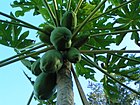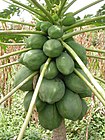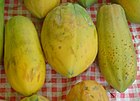Note: This is a project under development. The articles on this wiki are just being initiated and broadly incomplete. You can Help creating new pages.
Difference between revisions of "Carica papaya - Madhukarkati"
(→List of Ayurvedic medicine in which the herb is used) |
|||
| (9 intermediate revisions by 2 users not shown) | |||
| Line 1: | Line 1: | ||
[[File:Carica papaya 005.JPG|thumb|right|''Papaya'']] | [[File:Carica papaya 005.JPG|thumb|right|''Papaya'']] | ||
| − | + | '''Papaya''' is a large tree-like plant, with a single stem growing from 5 to 10 m (16 to 33 ft) tall, with spirally arranged leaves confined to the top of the trunk. | |
| − | |||
| − | |||
==Uses== | ==Uses== | ||
{{Uses|Digestive disorders}}, {{Uses|Healing wounds}}, {{Uses|Diabetes}}, {{Uses|Hypertension}}, {{Uses|High blood pressure}}, {{Uses|Malaria}}, {{Uses|Ulcer}}, {{Uses|Boils}}, {{Uses|Wounds}} | {{Uses|Digestive disorders}}, {{Uses|Healing wounds}}, {{Uses|Diabetes}}, {{Uses|Hypertension}}, {{Uses|High blood pressure}}, {{Uses|Malaria}}, {{Uses|Ulcer}}, {{Uses|Boils}}, {{Uses|Wounds}} | ||
| Line 10: | Line 8: | ||
==Chemical Composition== | ==Chemical Composition== | ||
| − | The green fruit is reported to contain 26 calories, 92.1 g H2O, 1.0 g protein, 0.1 g fat, 6.2 g total carbohydrate, 0.9 g fiber, 0.6 g ash, 38 mg Ca, 20 mg P, 0.3 mg Fe, 7 mg Na, 215 mg K, 15 ug beta-carotene equivalent<ref name="chemical composition"/> | + | The green fruit is reported to contain 26 calories, 92.1 g H2O, 1.0 g protein, 0.1 g fat, 6.2 g total carbohydrate, 0.9 g fiber, 0.6 g ash, 38 mg Ca, 20 mg P, 0.3 mg Fe, 7 mg Na, 215 mg K, 15 ug beta-carotene equivalent. Latex contain enzymes—papain and chymopapain and alkaloids carpaine and pseudocarpaine<ref name="chemical composition"/> |
==Common names== | ==Common names== | ||
| − | {{Common names|kn= | + | {{Common names|kn=Pappaya hannu|sa=Erand karkati|ta=Pappali|hi=Papita|en=Pawpaw, Papaya}} |
==Properties== | ==Properties== | ||
| Line 39: | Line 37: | ||
===Flower=== | ===Flower=== | ||
| − | {{Flower|Bisexual|2-6cm long| | + | {{Flower|Bisexual|2-6cm long|White|5-10|Flowers are solitary or small cymes of 3 individuals}} |
===Fruit=== | ===Fruit=== | ||
| − | {{Fruit| | + | {{Fruit|Oval|Fruits weigh from 0.5 up to 20 lbs|Fruit are borne axillary on the main stem|Usually singly but sometimes in small clusters|Many}} |
===Other features=== | ===Other features=== | ||
| Line 53: | Line 51: | ||
==How to plant/cultivate== | ==How to plant/cultivate== | ||
| − | Papaya succeeds in tropical and subtropical areas, where it can be found between 32°N and S. It produces best at elevations below 900 metres, though it can also succeed as high as 2,100 metres near the equator<ref name="How to plant/cultivate"/> | + | Seeds germinate readily. Papaya succeeds in tropical and subtropical areas, where it can be found between 32°N and S. It produces best at elevations below 900 metres, though it can also succeed as high as 2,100 metres near the equator<ref name="How to plant/cultivate"/> |
==Commonly seen growing in areas== | ==Commonly seen growing in areas== | ||
| Line 69: | Line 67: | ||
Image:Carica papaya dsc07806.jpg | Image:Carica papaya dsc07806.jpg | ||
Image:Papaya slice.jpg|Papaya slice | Image:Papaya slice.jpg|Papaya slice | ||
| − | Image:Papaya.jpg | + | Image:Papaya.jpg |
Image:California_Papaya_ID.jpg|Sweet California papaya, Indonesia | Image:California_Papaya_ID.jpg|Sweet California papaya, Indonesia | ||
Image:Papaya-oliv.jpg | Image:Papaya-oliv.jpg | ||
| Line 79: | Line 77: | ||
<references> | <references> | ||
| − | <ref name="chemical composition">[ | + | <ref name="chemical composition">[http://gbpihedenvis.nic.in/PDFs/Glossary_Medicinal_Plants_Springer.pdf Chemistry]</ref> |
| − | <ref name="Leaf">[http://www.fruit-crops.com/papaya-carica-papaya/ | + | <ref name="Leaf">[http://www.fruit-crops.com/papaya-carica-papaya/ Botonical description]</ref> |
| − | <ref name="How to plant/cultivate">[http://tropical.theferns.info/viewtropical.php?id=Carica+papaya | + | <ref name="How to plant/cultivate">[http://tropical.theferns.info/viewtropical.php?id=Carica+papaya Cultivation details]</ref> |
</references> | </references> | ||
==External Links== | ==External Links== | ||
| − | * [http://www.missouribotanicalgarden.org/PlantFinder/PlantFinderDetails.aspx?kempercode=d374 | + | * [http://www.missouribotanicalgarden.org/PlantFinder/PlantFinderDetails.aspx?kempercode=d374 Papaya on missori botonical garden] |
| − | * [http://eol.org/pages/585682/details | + | * [http://eol.org/pages/585682/details Papaya on encyclopedea of life] |
| − | * [http://www.extento.hawaii.edu/kbase/crop/crops/i_papa.htm | + | * [http://www.extento.hawaii.edu/kbase/crop/crops/i_papa.htm General crop information] |
| − | * [http://www.worldagroforestry.org/treedb/AFTPDFS/Carica_papaya.PDF | + | * [http://www.worldagroforestry.org/treedb/AFTPDFS/Carica_papaya.PDF Papaya description pdf] |
[[Category:Herbs]] | [[Category:Herbs]] | ||
[[Category:Caricaceae]] | [[Category:Caricaceae]] | ||
Latest revision as of 17:08, 15 September 2020
Papaya is a large tree-like plant, with a single stem growing from 5 to 10 m (16 to 33 ft) tall, with spirally arranged leaves confined to the top of the trunk.
Contents
- 1 Uses
- 2 Parts Used
- 3 Chemical Composition
- 4 Common names
- 5 Properties
- 6 Habit
- 7 Identification
- 8 List of Ayurvedic medicine in which the herb is used
- 9 Where to get the saplings
- 10 Mode of Propagation
- 11 How to plant/cultivate
- 12 Commonly seen growing in areas
- 13 Photo Gallery
- 14 References
- 15 External Links
Uses
Digestive disorders, Healing wounds, Diabetes, Hypertension, High blood pressure, Malaria, Ulcer, Boils, Wounds
Parts Used
Fruits, Leaves, Seeds, Flowers.
Chemical Composition
The green fruit is reported to contain 26 calories, 92.1 g H2O, 1.0 g protein, 0.1 g fat, 6.2 g total carbohydrate, 0.9 g fiber, 0.6 g ash, 38 mg Ca, 20 mg P, 0.3 mg Fe, 7 mg Na, 215 mg K, 15 ug beta-carotene equivalent. Latex contain enzymes—papain and chymopapain and alkaloids carpaine and pseudocarpaine[1]
Common names
| Language | Common name |
|---|---|
| Kannada | Pappaya hannu |
| Hindi | Papita |
| Malayalam | NA |
| Tamil | Pappali |
| Telugu | NA |
| Marathi | NA |
| Gujarathi | NA |
| Punjabi | NA |
| Kashmiri | NA |
| Sanskrit | Erand karkati |
| English | Pawpaw, Papaya |
Properties
Reference: Dravya - Substance, Rasa - Taste, Guna - Qualities, Veerya - Potency, Vipaka - Post-digesion effect, Karma - Pharmacological activity, Prabhava - Therepeutics.
Dravya
Rasa
Katu, Tikta
Guna
Laghu, Ruksa, Tikshna
Veerya
Ushna
Vipaka
Karma
Kaphavatahara, Hridya
Prabhava
Habit
Identification
Leaf
| Kind | Shape | Feature |
|---|---|---|
| Simple | 2 ½ ft wide | Stems appear as a trunk, are hollow, light green to tan brown, up to 8″ in diameter, and bear prominent leaf scars. |
Flower
| Type | Size | Color and composition | Stamen | More information |
|---|---|---|---|---|
| Bisexual | 2-6cm long | White | 5-10 | Flowers are solitary or small cymes of 3 individuals |
Fruit
| Type | Size | Mass | Appearance | Seeds | More information |
|---|---|---|---|---|---|
| Oval | Fruits weigh from 0.5 up to 20 lbs | Fruit are borne axillary on the main stem | Usually singly but sometimes in small clusters | Many | {{{6}}} |
Other features
List of Ayurvedic medicine in which the herb is used
Where to get the saplings
Mode of Propagation
How to plant/cultivate
Seeds germinate readily. Papaya succeeds in tropical and subtropical areas, where it can be found between 32°N and S. It produces best at elevations below 900 metres, though it can also succeed as high as 2,100 metres near the equator[3]
Commonly seen growing in areas
Lower rainfall, Island, Cooler temperature.
Photo Gallery
References
External Links
- Ayurvedic Herbs known to be helpful to treat Digestive disorders
- Ayurvedic Herbs known to be helpful to treat Healing wounds
- Ayurvedic Herbs known to be helpful to treat Diabetes
- Ayurvedic Herbs known to be helpful to treat Hypertension
- Ayurvedic Herbs known to be helpful to treat High blood pressure
- Ayurvedic Herbs known to be helpful to treat Malaria
- Ayurvedic Herbs known to be helpful to treat Ulcer
- Ayurvedic Herbs known to be helpful to treat Boils
- Ayurvedic Herbs known to be helpful to treat Wounds
- Herbs with Fruits used in medicine
- Herbs with Leaves used in medicine
- Herbs with Seeds used in medicine
- Herbs with Flowers used in medicine
- Herbs with common name in Kannada
- Herbs with common name in Hindi
- Herbs with common name in Tamil
- Herbs with common name in Sanskrit
- Herbs with common name in English
- Habit - Herb
- Index of Plants which can be propagated by Seeds
- Index of Plants which can be propagated by Cuttings
- Herbs that are commonly seen in the region of Lower rainfall
- Herbs that are commonly seen in the region of Island
- Herbs that are commonly seen in the region of Cooler temperature
- Herbs
- Caricaceae














